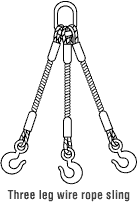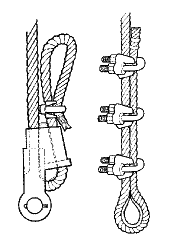Materials Handling - Wire Rope Slings
On this page
How should you select the proper wire rope sling?
Back to top- Follow the manufacturers' charts and tables on sling types, angles, and rope diameters and select a proper sling which suits the load and the slinging method that you are going to use. Sling types can be endless, single, two, three or four leg.



- The sling must be both long enough and strong enough for the load and the slinging method.
- Follow the manufacturers' recommendations on clips and clamps of suitable size and design for ropes of different size.
- Consult the manufacturer or supplier when wire rope slings come into contact with acids or chemicals.
- Attach using methods outlined by the manufacturer.
- Remember that a socket and clip fittings used to attach the rope determine the sling's load limit. Fittings have 75% to 100% of the breaking load of the rope.
- Remember that the safe load limit of a sling also depends on the hitch (method of applying a sling to the load). The type of hitch depends on the kind of material to be lifted, the safe load limit of the sling, the presence (or absence) of lugs on the load, the headroom, and other factors. Check with the manufacturers instructions.

Correct method to attach clips
How should you use wire rope slings safely?
Back to top- Be sure you know the correct use of the equipment, the slinging procedures and the sling strength factors to be applied before lifting.
- Use wire rope slings at rated limits.
- Check the manufacturer's chart for sling properties.
- Examine slings for wear, fatigue, crushed or broken wires, kinking, ballooning or "bird-caging", heat damage, etc. Check both before and after using slings to detect any damage or defects. See Hoist wire rope for more inspection tips.
- Attach the sling securely to the load and appliance and position hooks to face outwards.
- Protect slings by using corner saddles, paddings or wood blocks.
- Inspect and tighten fittings regularly.
- Ensure the load is balanced and will not tilt or fall.
- Center the sling load to prevent the load from shifting suddenly and causing a high impact load.
- Ensure that the load is free to be lifted.
- Keep fingers and toes clear when tensioning slings and when landing loads.
- Make a trial lift and trial lower to ensure everything is working in a safe manner.
- Reduce rope stress with slow starts and stops.
- Position hooks of multi-leg slings facing outward from the load.
- Back hook free legs to the master link to avoid lashing legs which might accidentally become engaged.
- Keep wire rope slings well lubricated and inspect them often. Use non-acidic lubricants.
- Remove damaged slings from service and tag appropriately.
- Store slings on racks in a clean, dry place and protect from corrosion.
What should you avoid when using wire rope slings?
Back to top- Do not bend slings around sharp edges.
- Do not force, hammer or wedge slings or fittings into position. They must fit freely.
- Never join wire rope slings made from different lays of rope together as it can seriously affect the lifting capacity.
- Do not use slings with knots.
- Never attempt to shorten or tie wire rope slings.
- Never shock load wire rope slings.
- Do not slide the load along a rope.
- Do not use a single leg hitch on a load that cannot be controlled; rotation of a load can undo the wire rope strands and weaken the rope.
- Do not make slings from discarded hoist wire rope.
- Fact sheet last revised: 2019-04-08

